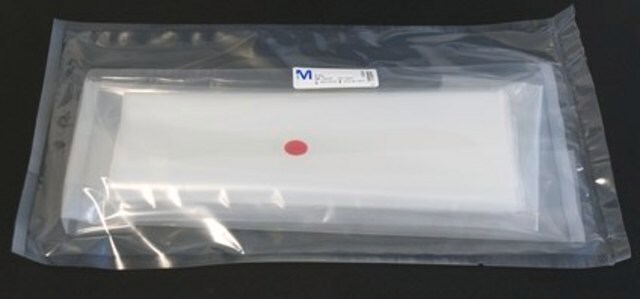0797
GVPC Agar

ready-to-use, plate of 20 × 23 ± 1 mL, selective for bacteria: Legionella spp
Se connecterpour consulter vos tarifs contractuels et ceux de votre entreprise/organisme
About This Item
Code UNSPSC :
41106217
Produits recommandés
Agence
ISO 11731
Forme
plate (Semi-solid Media Filled)
Caractéristiques
ready-to-use
Conditionnement
plate of 20 × 23 ± 1 mL
Technique(s)
microbiological culture: suitable
Taille de la plaque/du plateau
90 mm
pH
6.9 ± 0.2 (25 °C)
Application(s)
food and beverages
water monitoring
Température de stockage
2-8°C
Adéquation
selective for bacteria: Legionella spp
Catégories apparentées
Description générale
GVPC Agar, also known as Glycine-vancomycin-polymyxin-cycloheximide agar, is a Ready-to-Use media designed as per ISO Standards 11731 to detect Legionella spp.
The activated carbon in GVPC agar has an antitoxic effect due to the adsorption of fatty acids, but especially due to the breakdown of oxygen radicals and H2O2. Yeast extract provides the necessary proteins and nutrients. L-cysteine is an essential growth factor for all Legionella. The soluble iron (III) pyrophosphate [Fe4(P2O7)3] is used as a special iron source, whose quality significantly affects the growth of the Legionella. α-ketoglutarate stimulates the growth of legionella both as a carbon and nitrogen source (Krebs Cycle) as well as through mediation of the iron transport, the high amount of glycine and polymyxin B act against gram-negative, Vancomycin act against gram-positive bacteria of the accompanying bacterial flora. Cycloheximide acts fungicidal against both yeasts and molds. Thus, the selectivity of the medium is increased.
The activated carbon in GVPC agar has an antitoxic effect due to the adsorption of fatty acids, but especially due to the breakdown of oxygen radicals and H2O2. Yeast extract provides the necessary proteins and nutrients. L-cysteine is an essential growth factor for all Legionella. The soluble iron (III) pyrophosphate [Fe4(P2O7)3] is used as a special iron source, whose quality significantly affects the growth of the Legionella. α-ketoglutarate stimulates the growth of legionella both as a carbon and nitrogen source (Krebs Cycle) as well as through mediation of the iron transport, the high amount of glycine and polymyxin B act against gram-negative, Vancomycin act against gram-positive bacteria of the accompanying bacterial flora. Cycloheximide acts fungicidal against both yeasts and molds. Thus, the selectivity of the medium is increased.
Application
Glycine Vancomycin Polymyxin Cycloheximide (GVPC) Agar is a selective culture medium used for the isolation, detection and enumeration of Legionella spp. in water samples from various sources (water intended for human consumption, wastewater, thermal and mineral waters, etc.) and food and beverage samples.
Certificats d'analyse (COA)
Recherchez un Certificats d'analyse (COA) en saisissant le numéro de lot du produit. Les numéros de lot figurent sur l'étiquette du produit après les mots "Lot" ou "Batch".
Déjà en possession de ce produit ?
Retrouvez la documentation relative aux produits que vous avez récemment achetés dans la Bibliothèque de documents.
Notre équipe de scientifiques dispose d'une expérience dans tous les secteurs de la recherche, notamment en sciences de la vie, science des matériaux, synthèse chimique, chromatographie, analyse et dans de nombreux autres domaines..
Contacter notre Service technique



